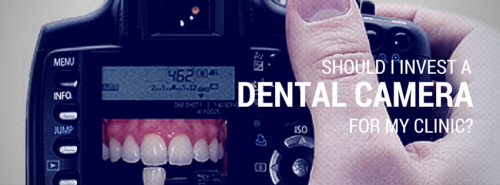
As the world of dentistry continues to evolve, taking pictures for documentation and treatment purposes has evolved greatly from merely clicking a camera at a patient’s teeth, to getting accurate visual information on everything that goes on in a patient’s mouth, be it the different contours of the centra incisors to the angle of an impacted wisdom tooth.
Acquiring such information from a picture however requires a camera that allows such precise details to be highlighted. With the ever improving technology in dental photography, clinics should consider the following before purchasing a dental camera:
Purpose
Will the camera be for teaching, or for documentation purposes? In teaching, a simpler lower-end camera would suffice, whereas for documenting aesthetics and complicated cases a higher-end camera would be considered the bare minimum.
Camera Type
There are 3 main types of Dental Cameras:
1 – Point and Shoot (lower-end)
These cameras are designed to simply point-and-shoot. Lenses do not move, and zoom is unavailable. Details are better than an average camera; however visibility past the first premolars will suffer or will not be visible at all.
2 – Fixed Lens (medium-range)
These cameras have lenses that can zoom within a specific range and can better catch details all the way to the Third Molars.
3 – Professional with Interchangeable Lens
As with most professional photography cameras, professional dental cameras come with an array of different lenses for different requirements. Macro lenses allow enlargement of the picture to an incredible size to catch minor details, and interchangeable flashes allow for different lighting requirements.
A general rule is to always choose a camera with a sharp focus. A sharp focus allows you to see stippling of the gingiva in the picture.
Previous Equipment
If your clinic has a good camera and needs to purchase new add-on such as a new lens or a new flash, always ensure that it is compatible with your current equipment. Not all camera manufacturing companies’ equipment are compatible with each other.
The Flash
There are two types of flash:
1 – Point Light
This is the usual for point-and-click cameras. The flash is located behind the lens, and may cause shadowing. However it enhances the contours on teeth and accentuates the incisal line.
2 – Ring Light
The flash is located around the lens. This increases the light on the picture, and flattens the image to give clear details. This is best used when minor details are required and large surface areas are being photographed.
Price
As technology continues to advance, professional cameras are getting cheaper and become more affordable to most clinics. While the fixed lens camera is more affordable, the difference between a fixed lens and a professional camera is decreasing. Should your clinic require a new camera, it may be wise to invest in a professional camera for the long term.
Still unsure which brand to buy?
Learning photo shooting techniques are too troublesome?
You just need something simple yet has sophisticated functions?
The new SHOFU EyeSpecial camera is designed exclusively for dentistry. With a 12 megapixels sensor, the EyeSpecial C-II has 8 pre-set dental shooting modes to aid dental technicians from routine intra-oral photography to in-lab use! Click here to find out more!








